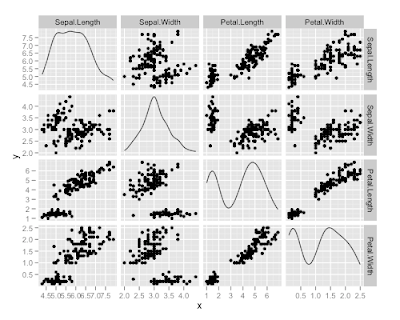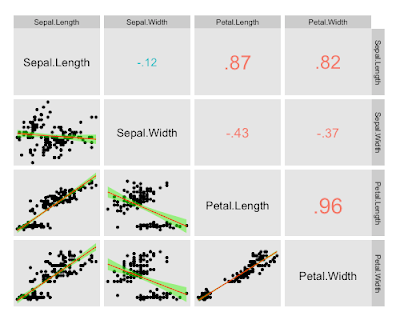UPDATE: At the bottom are two additional methods, and some additions (underlined) are added to the original 5 methods. Thanks for all the feedback...
-Also, another post here about ordered-categorical data
-Also #2, a method combining splom and hexbin packages here, for larger datasets
In data analysis it is often nice to look at all pairwise combinations of continuous variables in scatterplots. Up until recently, I have used the function splom in the package lattice, but ggplot2 has superior aesthetics, I think anyway.
Here a few ways to accomplish the task:
# load packages
require(lattice)
require(ggplot2)
1) Using base graphics, function "pairs"
Created by Pretty R at inside-R.org2) Using lattice package, function "splom"
-
Additional code to improve splom plots here (and see Oscar's code below in comments)Created by Pretty R at inside-R.org3) Using package ggplot2, function "plotmatrix"
Created by Pretty R at inside-R.org4) a function called ggcorplot by Mike Lawrence at Dalhousie University
-get ggcorplot function at
this link-
ggcorplot is also built in to Deducer (get here); see Ian's code below in the comments-
Lastly, an improved version of ggcorplot is built in to the ez package (get here)ggcorplot(
data = iris[1:4],
var_text_size = 5,
cor_text_limits = c(5,10))
5) panel.cor function using pairs, similar to ggcorplot, but using base graphics. Not sure who wrote this function, but
here is where I found it.
panel.cor <- function(x, y, digits=2, prefix="", cex.cor)
{
usr <- par("usr"); on.exit(par(usr))
par(usr = c(0, 1, 0, 1))
r <- abs(cor(x, y))
txt <- format(c(r, 0.123456789), digits=digits)[1]
txt <- paste(prefix, txt, sep="")
if(missing(cex.cor)) cex <- 0.8/strwidth(txt)
test <- cor.test(x,y)
# borrowed from printCoefmat
Signif <- symnum(test$p.value, corr = FALSE, na = FALSE,
cutpoints = c(0, 0.001, 0.01, 0.05, 0.1, 1),
symbols = c("", "", "", ".", " "))
text(0.5, 0.5, txt, cex = cex * r)
text(.8, .8, Signif, cex=cex, col=2)
}
pairs(iris[1:4], lower.panel=panel.smooth, upper.panel=panel.cor)
A comparison of run times...
Created by Pretty R at inside-R.org...shows that splom is the fastest method, with the method using the panel.cor function pulling up the rear.
6) given by a reader in the comments (get her/his code
here). This one is nice as it gives 95% CI's for the correlation coefficients, AND histograms of each variable.

7) a reader in the comments suggested the scatterplotMatrix (spm can be used) function in the car package. This one has the advantage of plotting distributions of each variable, and providing fits to each data with confidence intervals.









